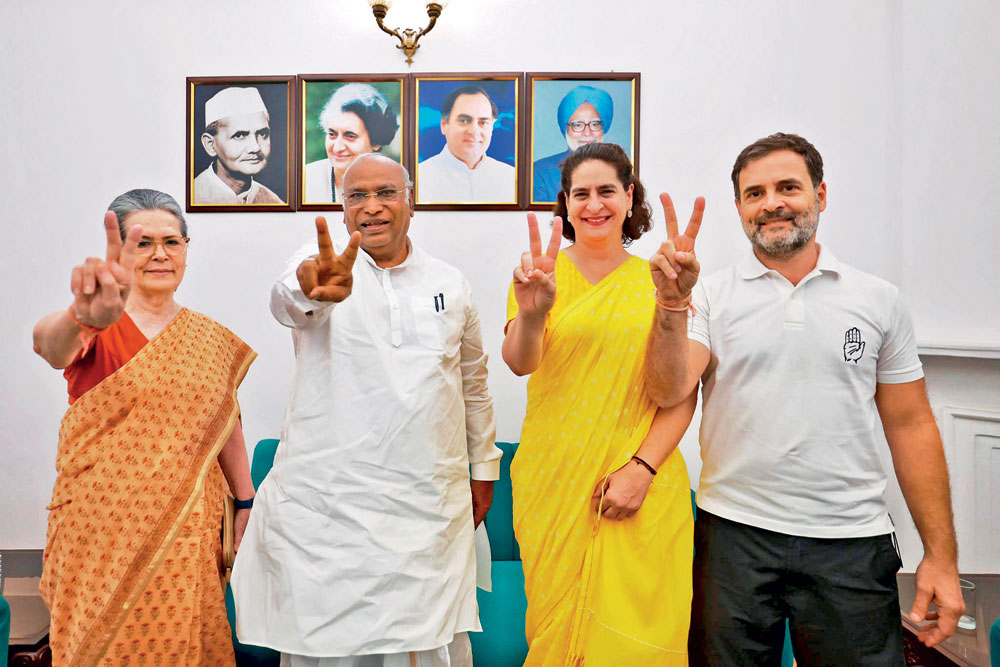A Shot At Redemption
Rahul Gandhi has led Congress out of the doldrums. Can the party sustain its new momentum?
 Rajeev Deshpande
Rajeev Deshpande
 Rajeev Deshpande
Rajeev Deshpande
 |
07 Jun, 2024
|
07 Jun, 2024
/wp-content/uploads/2024/06/Ashotatredemption.jpg)
Rahul Gandhi at Congress headquarters in New Delhi, June 4, 2024
WHEN THE 18TH LOK SABHA meets, Rahul Gandhi will be at the head of a large contingent of Congress MPs, just one short of 100. Congress benches will be flanked by detachments of Samajwadi Party (SP), Trinamool Congress (TMC), and the Dravida Munnetra Kazhagam (DMK), along with a sizeable presence of parties like the Shiv Sena (UBT) and the Nationalist Congress Party (Sharad Pawar). All told, the numbers make for a vociferous Opposition that can disrupt or block government business much more effectively than has been the case. And unlike in the previous two Lok Sabhas, the Congress tally meets the 10 per cent qualification bar—in terms of House strength—to claim the Leader of the Opposition designation. It is a remarkable turnaround for a leader who was disqualified as an MP in March last year after being convicted in a defamation case and it gives him a new shot at establishing himself as the head of an alternative political formation that stands in opposition to the National Democratic Alliance (NDA).
The positives do not, of course, mask the obvious downsides of Congress finding itself sitting in the Opposition benches third time running. But such has been the dominance of Prime Minister Narendra Modi and the Bharatiya Janata Party (BJP) that electoral performance of Congress is seen as a remarkable feat. Even though 99 represents the party’s third-worst performance, its improved strike rate in direct contests with BJP—which has been a one-way street since 2014—and success of alliances with SP, NCP, SS(UBT) and DMK prevented another sub-par outing and, importantly, prevented BJP from achieving a majority on its own. That’s why a modest increase in Congress’ vote share from 19.5 per cent in 2019 to a shade over 21 per cent in 2024 delivered disproportionate benefits in terms of seats. The combination of issues and a synergy in vote bases turned several contests towards Congress, leading to Rahul asserting at a post-result press conference that the verdict is an indictment of BJP top duo Modi and Union Home Minister Amit Shah. Holding a copy of the Constitution, he said the results are the first step towards saving democratic institutions. “We fought this election not just against BJP but governance structure of the country, intelligence agencies CBI and ED and judiciary because all these institutions are captured by Amit Shah and Narendra Modiji,” he said.
Rahul’s summing up of the results outlines his likely campaign against the government as Congress is also likely to see the verdict as a vindication of its manifesto promises to conduct a nation-wide socio-economic and caste census, do away with the 50 per cent cap on reservations, distribute government and ‘surplus’ land to the poor, set up a diversity commission to promote diversity in public and private employment, oppose a uniform civil code (UCC), implement a ₹1 lakh a year apprentice scheme, waive off education loans, provide ₹1 lakh per year for women from poor families, set up a commission to evaluate loan waivers, take measures to ensure a ‘fair share’ to minorities in public work contracts, and roll out work guarantees for the urban poor. The manifesto has populist overtones and the pledges to address inequality and ensure minority participation in the economy have a distinctly redistributive ring. Congress’ success will encourage Rahul to sharpen this plank which he believes can undo the social coalition BJP has forged. Even with reduced numbers, Rahul has nudged Congress to oppose almost all Modi government initiatives and party representatives on selection panels for posts like chiefs of the Central Vigilance Commission (CVC), the Central Bureau of Investigation (CBI) and election commissioners have submitted dissent notes since 2014. With BJP short of a majority in Lok Sabha, the Congress leader may well calculate that the government’s equity can be further eroded by adopting an adversarial posture in Parliament.

Did high-sounding issues like saving democracy and protecting constitutional probity weigh with voters? The evidence is scratchy at best. Interactions with voters and media reports did not offer much to support such a conclusion. The issues voters related to were more direct, connected to unpopular candidates, lack of development and opportunities, caste affiliations, or a perception of prospects under BJP and the available alternatives. On the larger canvas there was a discussion on whether the Modi government enhanced national prestige and the import of decisions such as the abrogation of Article 370 and the consecration of the Ram Mandir. While finalising their choices, voters ranked issues and evaluated what mattered most to them and most, including intended beneficiaries, were not clear about the advantage of a caste census. There was considerable scepticism about cash doles for youth and women and even voters inclined to back Congress did not think the payouts would be feasible or sustainable. What might have bothered voters, particularly Dalits in states like Uttar Pradesh (UP) where caste is never far from the surface, is the allegation that BJP is seeking a brute ‘400 par’ majority to fiddle with reservations. Here too, Dalits were not always too convinced, questioning if any leader or party could actually scrap reservations for Scheduled Castes (SCs) and Scheduled Tribes (STs). But it might have raised doubts that Congress and SP exploited. The BJP vote in Uttar Pradesh is 41.3 per cent, a decline from the 50 per cent it polled in 2019. The drop might be explained by a drift towards SP-Congress across communities as SP chief Akhilesh Yadav fielded candidates representing major social groups. It would include some erosion of non-Yadav OBC voters but the magnitude is not clear. Though its support dipped, a 41 per cent vote share is not likely without OBCs backing the party. The perception that the Bahujan Samaj Party (BSP) was a non-starter in this election seems to have boosted SP’s vote to 33.5 per cent from 18.1 per cent although it needs to be kept in mind that the party contested fewer seats in 2019 when it was in alliance with BSP.
The Congress leader is often the butt of jokes and there is a case that he has won his spurs, causing his supporters to assert that he took the right calls. Often enough, Rahul has defined his engagement with public life, choosing to stay out of limelight for long periods. In Parliament, he has intervened sporadically and his speeches are marked by direct and personal references. He taunts the treasury benches with “daro mat (don’t be scared)” jibes and claims the prime minister cannot look him in the eye. The leader’s second Bharat Jodo Yatra this year drew criticism for being timed when it would be more useful to finalise alliances ahead of the Lok Sabha election. As it happened, the alliances, barring the deal with the Aam Aadmi Party (AAP) in Delhi, worked out well and the yatra is seen to have been a catalyst for Congress, mobilising support and motivating cadre. His appearance has fluctuated between sporting an unruly beard— causing Assam Chief Minister Himanta Biswa Sarma to recall Saddam Hussein—and a completely clean-shaven look. At present the leader seems to have settled for a cropped beard that seems to retain a youthful but experienced touch. His trademark white T-shirt is intended to emphasise informality and fitness and is the look for almost all occasions. Having reversed the slump the party had been in, Rahul’s challenge lies in leading his party in Parliament by making his point through well-argued speeches. Stalling and disruption of Parliament is a headache for the government but can deliver diminishing returns while a well-articulated intervention holds public attention. Adroit use of the floor was what marked BJP when it was in Opposition from 2004 to 2014 with leaders like Sushma Swaraj and Arun Jaitley leveraging the parliamentary platform.
Having been derided as an underdog who lacked the smarts to take on BJP, Rahul has scored against the run of play. In the David versus Goliath battle he has gained heft and can claim he stuck to his instincts when others pointed to past failures
The encouraging news for Congress lies in the gains it registered in states like Maharashtra where it was pushed to the margins. It was part of the Maha Vikas Aghadi (MVA) as a junior partner of Shiv Sena and NCP. But the splits in the two regional outfits increased Congress’ salience and allowed it to contest more seats and this has paid off with the party recording the highest tally of 13. It has more seats than its allies and has overtaken BJP which saw a sharp fall from 23 seats to just nine, at par with Shiv Sena (UBT). In Karnataka, Congress could not replicate the lead it gained in the 2023 state elections but brought down BJP’s numbers by winning nine seats in Kalyana-Karnataka (formerly Hyderabad-Karnataka) and Central Karnataka. BJP had swept Karnataka in 2019, winning 25 of the 28 Lok Sabha seats. Congress re-established a beachhead in the Northeast where it was all but blanked out, winning seats in Nagaland, Manipur, and Meghalaya. Similarly, the party picked eight and five seats in Rajasthan and Haryana, respectively.
All these seats are positives for Congress as they whittled down BJP numbers while the Opposition party reoccupied political space denied since 2014. This could, if the party plays its cards well, open the doors to reclaiming the support of constituencies that deserted Congress and switched their loyalties to regional parties or BJP. The reasons for the favourable outcomes need more attention as these are mostly local conditions and BJP’s overdependence on Modi. The Jat factor is important in BJP’s deficits in Haryana and eastern Rajasthan where the community is disgruntled about the perception that it has been sidelined. Jats in Haryana are displeased about the replacement of Manohar Lal Khattar as chief minister with another non-Jat Nayab Saini. In Rajasthan, the wait for a non-Jat chief minister has been interminable. Jats found some solace when BJP leader Vasundhara Raje was chief minister as she married into the house of Dholpur, a former Jat state. BJP’s decision to name a relative nonentity like Bhajan Lal Sharma, a Brahmin, as chief minister heightened the alienation and was instrumental in the party’s setbacks in Rajasthan. The muddled political situation in Maharashtra threw up several contradictions, not the least being Muslim support for Shiv Sena (UBT). BJP has been forced to deal with a set of bad choices to regain office in a state where the Shiv Sena walked out of a pre-poll alliance to seal a deal with NCP and Congress in 2019. While many more contributory factors can be listed, it remains unclear whether Congress’ populist “five guarantees” or the “democracy is in danger” pitch brought in the votes.
Having been derided as an underdog who lacked the smarts to take on BJP, Rahul Gandhi has scored against the run of play. In the David versus Goliath battle he has gained heft and can claim he stuck to his instincts when others pointed to past failures, such as the allegations of corruption in the Rafale deal that flopped. He has an opportunity to indulge in honest introspection about what went wrong in the past and perhaps, more importantly, what actually worked for Congress. Since the defeat in 2014, Rahul has tended to blame BJP for “institution capture” and the subversion of the judiciary and the media rather than acknowledge organisational weaknesses. This time, too, going by his initial remarks, the leader feels the odds were unfairly stacked against Congress for similar reasons. This reasoning finds resonance in the Congress echo chamber comprising BJP’s critics and opponents who claim the results would have been even more impressive if there had been an “even” playing ground. Their allusion is to the use of electoral bonds—now scrapped by the Supreme Court—and the alleged misuse of enforcement agencies against Opposition leaders. This is a tricky argument, more suited for propaganda than a viable political line which impresses voters. Some rules of politics are universal— parties that figure out bread-and-butter issues do better.

/wp-content/uploads/2025/07/Cover-Shubman-Gill-1.jpg)












More Columns
‘Fuel to Air India plane was cut off before crash’ Open
Shubhanshu Shukla Return Date Set For July 14 Open
Rhythm Streets Aditya Mani Jha